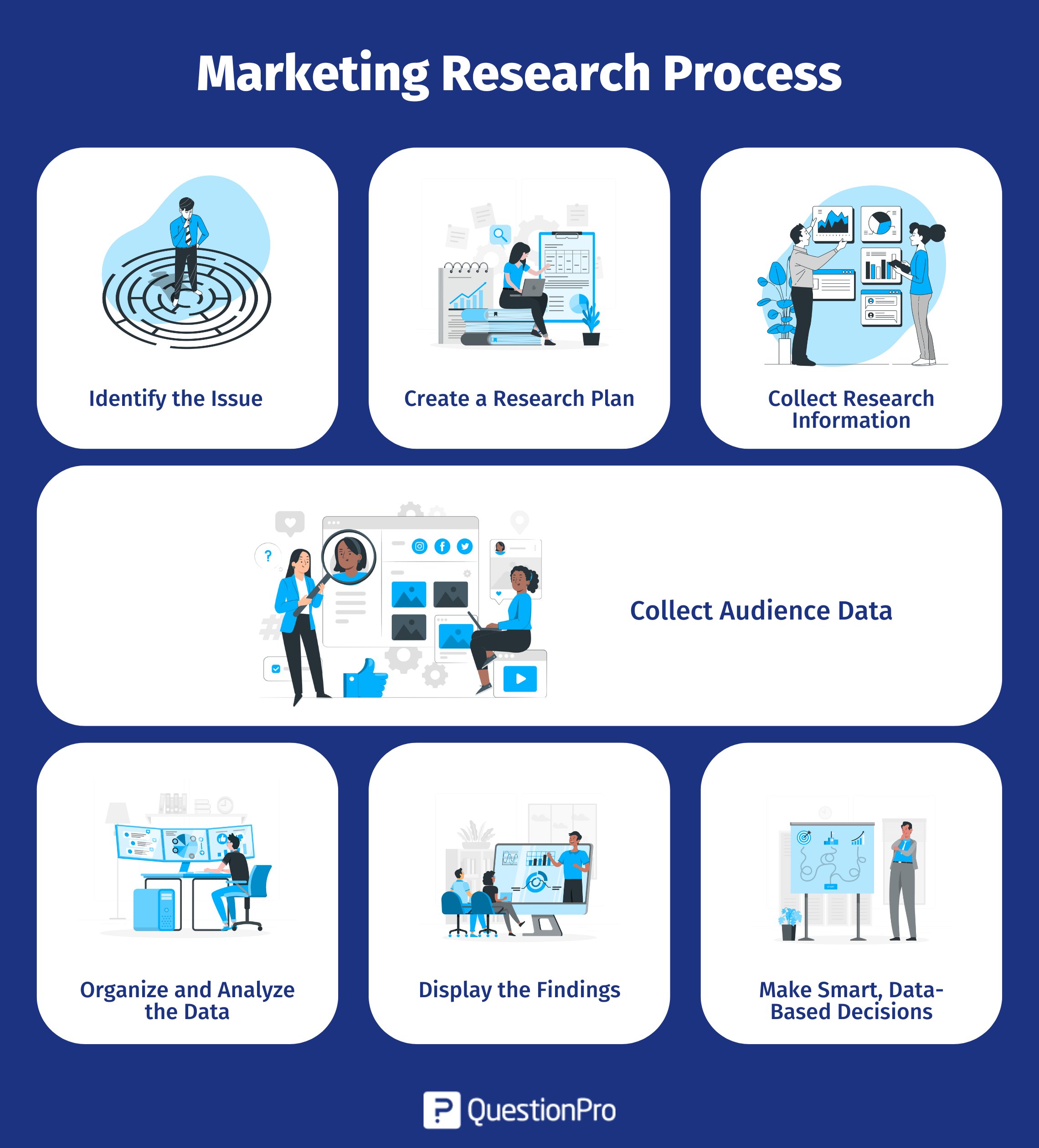
Have you ever wondered about the difference between market research vs marketing research? You’re not alone. A lot of people mix them up because they sound so similar and they’re closely related. But here’s the thing: they’re not exactly the same.
If you’re working in business, launching a product, or even just curious about how companies make smart decisions, knowing the difference can really help.
In this blog, we will explore the key differences between market research and marketing research in simple terms, explore how each one works, walk through their processes, and help you understand when to use which, so you can make smarter business decisions with confidence.
What is Market Research?
Market research investigates and analyzes a target market. Researchers use market research to collect consumer data within a marketplace. It deals with the collection, analysis, and use of market intelligence and market statistics. Market research deals with only one of Marketing’s four Ps – Place. In this context, place means a specific segment or market.
Market researchers collect, analyze, and study data about:
- An existing product or service, or a developing concept
- An existing marketplace
- Clients and customers
Researchers use market research to understand the marketplace’s wants, needs, behavior, purchase behavior, and other characteristics. It helps them understand and compare their products and services with their competitors and industry standards. Businesses use market research to understand the behavior of their customers towards newly launched products and services. It is also used to explore fresh markets and understand consumers’ needs in the marketplace – both existing and new.
The Market Research Process
You’ve heard that market research is super important, but how exactly do you do it? Don’t worry. You don’t need to be a data scientist to get started. In fact, once you break it down, the market research process is pretty straightforward. Let’s walk through it step by step, together.
1. Identify the Issue
First things first, what are you trying to figure out? This is the most important step, because if you don’t know what question you’re trying to answer, your research won’t be helpful. Maybe you want to know why sales are dropping, or what customers think about a new product idea. Whatever it is, be clear about the issue you want to solve.
Think of it like this: you’re setting the GPS before starting a road trip. You need to know the destination.
2. Choose Your Research Team
Now, who’s going to do the research? You have two choices here:
- Internal team: If you have a team with experience, you can keep it in-house.
- External experts: If you need specialized help or a fresh perspective, hiring a research agency is a good move.
Just make sure whoever handles it understands your marketing research aims and has the tools to dig into the data.
3. Pick the Right Method
The next thing is, how will you gather the information? There are lots of ways to collect market data, like:
- Online surveys
- One-on-one interviews
- Focus groups
- Observing consumer behavior
- Social media listening
Choose the method (or mix of market research methods) that fits your audience and your budget. No need to overcomplicate this; go with what works best for your question and your people.
4. Gather the Data
Time to roll up your sleeves. Start reaching out to your target audience and collecting the data. This could mean sending out surveys, doing interviews, or watching how customers interact with your product or service. This step takes time, but it’s where all the gold lives. Be patient and thorough.
5. Organize, Analyze, and Interpret the Data
Once you have all that raw data, it’s time to make sense of it. Look for trends, patterns, and insights. For example, are customers all saying the same thing about your pricing? Is one age group more interested in your service than another? Don’t just collect data, understand what it’s telling you.
6. Create a Report
Now that you’ve got the insights, it’s time to pull everything together. Create a simple, clear report that highlights:
- What you discovered
- What it means for your business
- Any surprising findings
- Charts or graphs (if they help tell the story)
You don’t need a 50-page document. Just make it easy for you and your team to understand.
7. Make Data-Based Decisions
This is where the magic happens. Take everything you’ve learned and use it to make smart decisions. Whether it’s tweaking a product, changing your pricing, or focusing on a new customer group, now you have real data to back up your choices.
What is Marketing Research?
Marketing research is a much broader concept than market research and deals with Marketing’s four Ps – product, price, place, and promotion. Its cover is much more diverse than that of market research. The areas that marketing research looks at are as follows:
- New product research
- Customer research
- Public relations
- Existing product development
- Distribution methods
- Sales
- Advertising research
- Pricing
Marketing research covers a lot – from the conception of the idea to the product’s development and placement. It does not stop there because it also covers the alterations and evolution of the products and services. It also looks into its growing customers and audience and helps in building brand awareness and brand equity. Market research plays a vital role in marketing research activities as it is a subset of marketing research.
The Marketing Research Process
If you’re trying to improve your product, launch a new campaign, or just understand your customers better, then marketing research is your best friend. But where do you start?
Let’s walk through the marketing research process together, step by step. No jargon, no fluff, just real talk.

1. Identify the Issue, Explore Options & Set Your Goals
Before you do anything, ask yourself: What’s the problem I’m trying to solve?
Maybe your sales have dropped, or your latest ad campaign didn’t hit the mark. Maybe you’re launching something new and want to be sure it lands well. Once you’ve nailed down the issue, look at your options and set clear objectives.
For example: “We want to know why fewer people are clicking on our ads,” or “We want to find out what features customers want most in our app.”
2. Create a Research Plan
Now that you know what you want to find out, it’s time to figure out how you’re going to do that. This is your research program; it’s basically your game plan.
Ask yourself:
- What methods will you use? (Surveys, focus groups, online polls, etc.)
- Who do you need to reach? (Existing customers? Potential buyers?)
- What tools or platforms will help you gather the info?
The goal here is to build a plan that fits your budget, timeline, and audience.
3. Collect Research Information
Now, it’s time to start collecting information that can help you answer your big question.
This might include:
- Past sales reports
- Website or social media performance
- Customer reviews and feedback
- Industry reports
This is where you dig into what you already know and what you can gather from outside sources.
4. Collect Audience Data
Next up, go straight to the source, your audience. This step is all about hearing directly from the people you’re trying to reach. You can:
- Send out surveys
- Conduct interviews
- Run focus groups
- Set up polls on social media
What do they like? What do they hate? What would make them choose you over a competitor? This is where you get real insights.
5. Organize and Analyze the Data
Now that you’ve got all this information, it’s time to make sense of it.
Look for patterns. Are lots of people complaining about the same thing? Are your best-performing ads targeting a specific age group? These clues help you understand what’s working and what’s not.
Don’t let the data just sit there. Dig into it, highlight the trends, and start connecting the dots.
6. Display the Findings
Once you’ve analyzed the data, share what you’ve learned in a way that makes sense.
You can put together:
- A simple report
- Charts or visuals
- Key takeaways for your team
Keep it clear and straight to the point. No need to impress anyone with big words—just explain what the data is telling you.
Think of it like telling a story: here’s what we wanted to know, here’s what we found, and here’s what it means.
7. Make Smart, Data-Based Decisions
This is the whole reason you did all that work. Now that you understand your customers, your market, and what’s working (or not), it’s time to take action.
You might:
- Adjust your pricing
- Change your marketing message
- Improve your product
- Try new platforms for advertising
Whatever decision you make, you’re not guessing you’re using real insights.
Recommended Read: 15 Market Research Tools For Your Business Growth
Market Research vs Marketing Research: Key Differences Explained
If you’ve ever found yourself wondering whether market and marketing research are just two names for the same thing, you’re not alone. Many people use the terms interchangeably, and while they are closely connected, they’re definitely not identical. Each plays a unique role in helping businesses grow, make smart decisions, and stay ahead of the competition.
To clear up the confusion, let’s take a closer look at how these two types of research differ and how each one can help you depending on your business goals.
Below is a comparison between market research and marketing research.
Aspect | Market Research | Marketing Research |
Main Focus | Looks specifically at the market, the buyers, competitors, trends, and overall environment. | Focuses on the entire marketing process, including product, pricing, promotion, and placement. |
| Purpose | To understand buyer behavior, market demand, and how a product or service performs in the marketplace. | To support decision-making across all marketing activities by gathering and analyzing data. |
| Scope of Research | Narrower scope. It mainly studies customers, competitors, and the market segment. | Much broader. It covers all four Ps of marketing and dives into everything from product design to ad performance. |
| Use Case | Best for learning about your target audience or testing a specific market. | Ideal when evaluating or improving your overall marketing strategy. |
| Nature of Research | Usually more focused and question-specific (e.g., “Will this product sell in this market?”). | More comprehensive, often solving a wide range of marketing-related challenges. |
| Supports | Acts as a subset of marketing research. | Drives the entire marketing intelligence system of a business. |
Conclusion
So, now you know market research and marketing research aren’t just two ways of saying the same thing. They each serve a different purpose, and depending on what you’re trying to learn or improve, you’ll need one, the other, or even both.
If your focus is understanding your target audience, testing a new product idea, or exploring a new market, market research is the tool for the job. But if you’re taking a step back and looking at the bigger picture, your product development, pricing, promotions, and overall strategy, then you’re in marketing research territory.
Need help getting started? Platforms like QuestionPro make the research process easier by offering tools for surveys, data analysis, audience targeting, and more, all in one place. Whether you’re exploring market research or managing a full-scale marketing study, they’ve got the features to help you turn insights into action.
Frequently Asked Questions (FAQs)
Answer: Market research helps you understand your customers’ needs, preferences, and buying habits, which enables you to create better products, enter new markets, and stay competitive.
Answer: The market research process includes identifying the issue, selecting a research team, choosing the research method, gathering data, analyzing and interpreting it, reporting findings, and making data-driven decisions.
Answer: Marketing research provides data on customer preferences, market trends, and campaign effectiveness, helping you tailor your messaging and target the right audience for better results.
Answer: Yes, market research is a subset of marketing research. It specifically focuses on understanding the market environment, while marketing research covers the entire marketing mix.
Answer: There are many tools available, including survey platforms like QuestionPro, social media listening tools, analytics software, and focus group services that help collect and analyze data efficiently.







